


|
Two projects: BV.P.163 and BV.P.166 can't be called 100% asymmetric, because their asymmetricity concerns
only their different nacelles at the tips of the wing. Anyway both are included, because their main airframe
components are really asymmetric.
|
|
Interview with Richard Vogt. Hermann Pohlmann: "Chronik eines Flugzeugwerkes" p.172 BV.P.163 |
| Type: Schnellbomber / Fernzerstoerer
Engine: Dimensions: Length: Weight: |
Performance: Maximum Speed: 543kph (BV.P.163.01) 570kph (BV.P.163.02) Range: Armament: |




|
 me anytime!
me anytime! PREV.: BV.P.111
PREV.: BV.P.111  NEXT: BV.P.165
NEXT: BV.P.165
